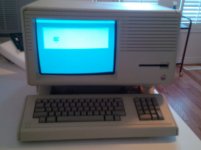I had a friend come over who has worked with CRTs before ans we worked on it together yesterday. I felt kinda odd asking him if I could video tape the event so I apologize for not recording it

It was a fairly simple procedure once you know your CRT is discharged (mine was already discharged) and you have a second set of hands.
Removing the CRT
1. Discharge the CRT
2. Remove the anode wire
3. Remove the two horizontal/vertical connectors that come out of the bottom of the yoke. On mine, you don't have to know what way the connector goes because it only goes one way but you DO need to remember which connector goes where.
4. take off the CRT/yoke protector metal bracket. Three screws on the inside enclosure right next to the tube neck (two on the sides, one above) and one on the other side where the boards go.
5. Remove the four front screws while someone supports the CRT tube
6. Wiggle off the round CRT neck connector on the end (being very careful).
7. Take notice of how the yoke is positioned. You can look where the yoke vertical/horizontal wires are connected but inside, I noticed the two coils of wire were separated between top half and bottom half. My yoke had two plastic "nubs" that stuck out at the sides. If these are aligned horizontally, then it should be semi-okay in terms of adjustments (I hope)
8. Remove the yoke by loosening the one clamp on the neck and carefully slip off the yoke.
8. Once the CRT is free of the chassis, one screw on the yolk needs to be loosened and then you can take the yoke off.
Mine was broken within the yoke so I had to clean off some glass inside the yoke. I'm not sure if there was any adhesive in there but I did have to scrape glass off of the inside diameter.
I decided to replace the yoke on the replacement CRT with the original yoke for two reasons. The first was due to advise here that makes sense and the second is because the vertical/horizontal wires were in one connector and the original yoke had two two-wire connectors. I didn't want to cut and splice wires or modify the connector so this was easier but I'm still a little worried about the DAG wire, that I did NOT put on.
Replacing the CRT
1. From the replacement CRT, remove the old yoke if there is one
2. Place the new yoke on the replacement CRT and adjust
3. Since I had two plastic "nubs" on my original yoke, I used those to line up the yoke and then screwed the clamp tight.
4. Wiggle on the round CRT neck connector on the end (being very careful).
5. Replace the four front screws while someone supports the CRT tube
6. Put on the CRT/yoke protector metal bracket.
7. Replace the two horizontal/vertical connectors that come out of the bottom of the yoke.
8. Replace the anode wire
You're done!
Now, the only issue that I cad was that I couldn't try it. My I/O board needs work (if I can bring it back from the dead) and my power supply possibly needs work too because my Lisa is completely dead. Sadly, I can't claim success because I don't know if this works. I do know I'm a step closer to getting my Lisa fixed, I hope.
Sorry I couldn't provide a video or proof that it works but I hope this was useful.

